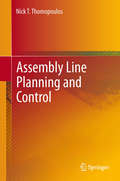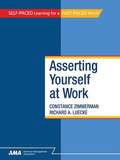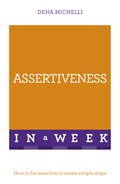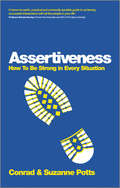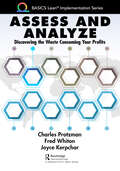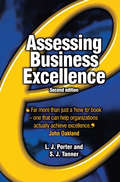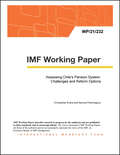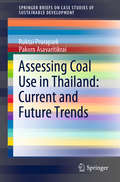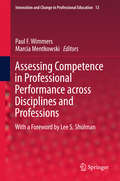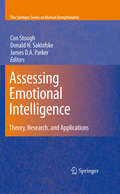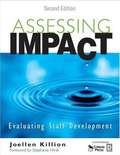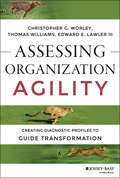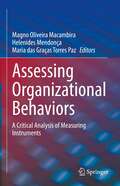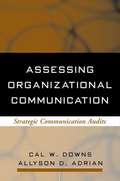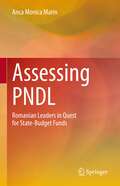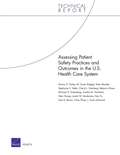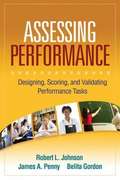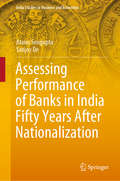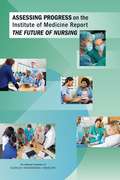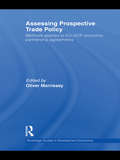- Table View
- List View
Assembly Line Planning and Control
by Nick T. ThomopoulosAssembly Line Planning and Control describes the basic fundamentals of assembly lines for single model lines, mixed model make-to-stock lines, mixed model make-to-order lines and for one-station assembly. The book shows how to select the quantity of units to schedule for a shift duration, compute the number of operators needed on a line, set the conveyor speed, coordinate the main line with sub-assembly lines, assign the work elements to the operators on the line, sequence the models down the line, sequence the jobs down the line, calculate the part and component requirements for a line and for each station, determine the replenish needs of the parts and components from the suppliers, compute the similarity between the models being produced and show applications, use learning curves to estimate time and costs of assembly, and measure the efficiency of the line. The material is timeless and the book will never become obsolete. The author presents solutions with easy-to-understand numerical examples that can be applied to real-life applications.
Assembly-Line Balancing under Demand Uncertainty (Gabler Theses)
by Celso Gustavo Stall SikoraAssembly lines are productive systems, which are very efficient for homogeneous products. In the automotive industry, an assembly line is used in the production of several vehicle variants, including numerous configurations, options, and add-ins. As a result, assembly lines must be at the same time specialized to provide high efficiency, but also flexible to allow the mass customization of the vehicles. In this book, the planning of assembly lines for uncertain demand is tackled and optimization algorithms are offered for the balancing of such lines. Building an assembly line is a commitment of several months or even years, it is understandable that the demand will fluctuate during the lifetime of an assembly line. New products are developed, others are removed from the market, and the decision of the final customer plays a role on the immediate demand. Therefore, the variation and uncertainty of the demand must be accounted for in an assembly line. In this book, methods dealing with random demand or random production sequence are presented, so that the practitioners can plan more robust and efficient production systems.
Assembly: Matter, Lineament, and Aggregated Systems in Architectural Production
by Michael Meredith Gail Peter BordenPart-to-part relationships and the approach to governing their sensibilities is at the root of all architecture. The need for engaging in a dialogue around these systems is essential to contemporary architectural discourse and practice. Assembly builds on and extends the investigations of materials and representation techniques in the editors’ previous books, Matter and Lineament. This book uses a collection of detailed case studies, explained by first-person authors, about experimental and innovative takes on assembling architecture. Bridging theory and practice, 17 projects and their principled approaches each demonstrate an important vein of inquiry within the topic. Essays probe issues such as latent and overt geometry, fabrication and technology, part-to-part elements, joinery and representation, material vernacular geometries, labor and place-based contextual assemblies, detailing, and pedagogical examinations. This text articulates the traditions and trends of material as the defining premise in the contemporary making of architecture. Its outcomes are applicable to beginning students of architecture and advanced practitioners alike.
Asserting Yourself at Work
by Richard Luecke Constance ZimmermanTechniques for managing others while maintaining mutual respect. Asserting Yourself at Workprovides business professionals with the communication tools and psychological foundation they need to perform more assertively on the job. Designed for front-line managers, supervisors, team leaders, team members, employees, and life-long learners, this course promotes the use of direct, inclusive communication as a powerful tool for achieving targeted goals and building lasting relationships. Asserting Yourself at Workteaches students the skills they need to behave and communicate more assertively—and therefore more effectively—in the workplace. Students learn to address their needs and interests at work, and, at the same time, consider the needs and interests of others. Beginning with the foundation of self-awareness, the course builds these skills step by step. Students learn about and practice assertive verbal and nonverbal communication techniques, learn how to set proper boundaries in workplace relationships, and analyze how assertiveness plays out in other cultures. The interactive format includes self-assessment tools, worksheets, sidebars, exercises, and quizzes that prompt students all along the way. Course Objective: Understand techniques for managing others while maintaining mutual respect and recognize and avoid self-defeating behaviors. Selected Learning Objectives • Set boundaries • Manage others without being aggressive or manipulative • Respond to other people's needs without giving up your own • Say "no" to unfair demands • Resolve conflicts and deal with aggressiveness in others • Enhance your self-image—and your on-the-job authority
Assertiveness In A Week: How To Be Assertive In Seven Simple Steps
by Dena Michelli'A useful confidence-building tool for those whose key aim is to find their inner power' Edge OnlineBeing more assertive just got easierMuch has been spoken about the assertive communication style, not all of it complimentary! Many people confuse it with being aggressive, bamboozling others into submission and getting what you want, despite what they want. However, assertive communication is not domineering; it's just a means of saying what you mean, meaning what you say and allowing others to do the same.Taking the decision to adopt assertive behaviour will mark the beginning of a new way of life: a way of life where you make your own decisions and choices without feeling guilty, and where you are in control, not those around you.By working through some simple steps, and by testing the techniques out in a 'safe' environment, you will soon become confident in your new-found powers of assertion. You will be able to command the respect of others, achieve your personal and professional goals and raise your self-esteem.The steps to assertive behaviour you will cover in this book are:- Understand the different styles of communication and the effect they have.- Identify your own style(s) of communication.- Know your own worth and the worth of others.- Be clear about your goals.- Be prepared to learn from your successes and failures.- Be flexible, and don't expect too much.- Learn to listen.Each of the seven chapters in Assertiveness In A Week covers a different aspect of being assertive:- Sunday: Preparing the foundations- Monday: Creating winning scenarios- Tuesday: Dealing with the 'negative'- Wednesday: Creating a positive impression- Thursday: Being assertive in public- Friday: Body language- Saturday: Personal power
Assertiveness: How To Be Strong In Every Situation
by Suzanne Potts Conrad PottsHow to overcome challenges with confidenceNo matter how successful we are, we all face stressful and hard-to-handle challenges in daily life, and - if we want to be as happy and healthy as we can - we must learn to assert ourselves, make our voices heard and approach life with confidence and self-assurance.This book is a roadmap to help you navigate your way through those challenging opportunities, hurdles and milestones. Taking universal scenarios case by case, and packed with practical tips, this inspiring, down-to-earth book will give you the tools to build your self-esteem and become happier, healthier, and in control of your own destiny.Written in an approachable style which posits practical solutions to a range of universal problemsDeals with assertiveness in business, family, social situations and all areas of lifeCovers topics like 'dealing with your boss', 'dealing with finances', 'asking for a pay rise', 'saying no at work'
Assess Current Challenges and Opportunities: The Role of Assessment in Successful Negotiation
by Richard S. Tedlow Lawrence Susskind Heather Beckham Hallam MoviusThis chapter explains the current state of play in an organization in terms of negotiation issues, challenges, stakeholders, processes and outcomes. The authors' program introduces a criteria assessment key that will help organizations develop their own successful negotiation practice. This chapter was originally published as chapter 3 of "Built to Win: Creating a World-Class Negotiating Organization."
Assess and Analyze: Discovering the Waste Consuming Your Profits (BASICS Lean® Implementation)
by Charles Protzman Fred Whiton Joyce KerpcharLean is about building and improving stable and predictable systems and processes to deliver to customers high-quality products/services on time by engaging everyone in the organization. Combined with this, organizations need to create an environment of respect for people and continuous learning. It’s all about people. People create the product or service, drive innovation, and create systems and processes, and with leadership buy-in and accountability to ensure sustainment with this philosophy, employees will be committed to the organization as they learn and grow personally and professionally. Lean is a term that describes a way of thinking about and managing companies as an enterprise. Becoming Lean requires the following: the continual pursuit to identify and eliminate waste; the establishment of efficient flow of both information and process; and an unwavering top-level commitment. The concept of continuous improvement applies to any process in any industry. Based on the contents of The Lean Practitioner’s Field Book, the purpose of this series is to show, in detail, how any process can be improved by utilizing a combination of tasks and people tools and introduces the BASICS Lean® concept. The books are designed for all levels of Lean practitioners and introduce proven tools for analysis and implementation that go beyond the traditional point kaizen event. Each book can be used as a stand-alone volume or used in combination with other titles based on specific needs. Each book is chock-full of case studies and stories from the authors’ own experiences in training organizations who have started or are continuing their Lean journey of continuous improvement. Contents include valuable lessons learned and each chapter concludes with questions pertaining to the focus of the chapter. Numerous photographs enrich and illustrate specific tools used in Lean methodology. Assess and Analyze: Discovering the Waste Consuming Your Profits explores the tools used to assess and analyze the process. It starts off with Learning to See waste and follows with the three analysis tools: mapping the product flow, documenting the full work of the operator, and implementing SMED or changeover reduction and closes with exploring Lean and change management.
Assessing Accounting Risk
by David F. HawkinsDescribes a framework that financial analysts can use to assess the likelihood of accounting misstatements in financial statements.
Assessing Business Excellence: A Guide To Business Excellence And Self-assessment
by L. J. Porter S. J. TannerAssessing Business Excellence presents a strategic framework for business excellence and total quality management and shows how you can be actively involved in continuous improvement by systematically reviewing your business activities and results against holistic business excellence frameworks.For all practitioners who seek to use total quality management to improve their organization's effectiveness, efficiency and responsiveness, this title is the essential route map to business excellence. From two leading expert authors comes a book where the most recognized quality award criteria are used to explore the concepts of business excellence and self-assessment. This book:* Introduces the major business excellence and total quality frameworks including The Malcolm Baldrige National Quality Award and the European Quality Award and ISO9000:2000* Compares the frameworks and identifies their strengths and limitations * Introduces the self-assessment process * Explores the main approaches to self-assessment * Illustrates the practical benefits of self-assessment through case examples
Assessing Chile’s Pension System: Challenges and Reform Options (Imf Working Papers)
by Christopher Evans and Samuel PienknaguraA report from the International Monetary Fund.
Assessing Coal Use in Thailand: Current and Future Trends (SpringerBriefs on Case Studies of Sustainable Development)
by Ruktai Prurapark Pakorn AsavaritikraiThis book highlights Thailand’s growing demand for clean energy from coal. The main source of energy for electricity production in Thailand (70%) is currently natural gas. However, natural gas extraction remains limited, resulting in an increasing need to import natural gas from other countries, which in turn leads to rising prices and unstable supplies. As such, coal energy is essential for industrial use and electricity production in Thailand. The book discusses the importance of developing and implementing clean technologies for coal. It also argues that collaborations between the government, private sector and the public are vital to achieving a mutual understanding and acceptance of coal energy and clean technologies, as well as a reduction in harmful emissions.
Assessing Competence in Professional Performance across Disciplines and Professions (Innovation and Change in Professional Education #13)
by Paul F. Wimmers Marcia MentkowskiThis book examines the challenges of cross-professional comparisons and proposes new forms of performance assessment to be used in professions education. It addresses how complex issues are learned and assessed across and within different disciplines and professions in order to move the process of "performance assessment for learning" to the next level. In order to be better equipped to cope with increasing complexity, change and diversity in professional education and performance assessment, administrators and educators will engage in crucial systems thinking. The main question discussed by the book is how the required competence in the performance of students can be assessed during their professional education at both undergraduate and graduate levels. To answer this question, the book identifies unresolved issues and clarifies conceptual elements for performance assessment. It reviews the development of constructs that cross disciplines and professions such as critical thinking, clinical reasoning, and problem solving. It discusses what it means to instruct and assess students within their own domain of study and across various roles in multiple contexts, but also what it means to instruct and assess students across domains of study in order to judge integration and transfer of learning outcomes. Finally, the book examines what it takes for administrators and educators to develop competence in assessment, such as reliably judging student work in relation to criteria from multiple sources. ". . . the co-editors of this volume, Marcia Mentkowski and Paul F. Wimmers, are associated with two institutions whose characters are so intimately associated with the insight that assessment must be integrated with curriculum and instructional program if it is to become a powerful influence on the educational process . . . " Lee Shulman, Stanford University
Assessing Emotional Intelligence: Theory, Research, and Applications (The Springer Series on Human Exceptionality)
by James D. Parker Donald H. Saklofske Con StoughManaging human emotions plays a critical role in everyday functioning. After years of lively debate on the significance and validity of its construct, emotional intelligence (EI) has generated a robust body of theories, research studies, and measures. Assessing Emotional Intelligence: Theory, Research, and Applications strengthens this theoretical and evidence base by addressing the most recent advances and emerging possibilities in EI assessment, research, and applications. This volume demonstrates the study and application of EI across disciplines, ranging from psychometrics and neurobiology to education and industry. Assessing Emotional Intelligence carefully critiques the key measurement issues in EI, and leading experts present EI as eminently practical and thoroughly contemporary as they offer the latest findings on: EI instruments, including the EQ-I, MSCEIT, TEIQue, Genos Emotional Intelligence Inventory, and the Assessing Emotions Scale. The role of EI across clinical disorders. Training professionals and staff to apply EI in the workplace. Relationships between EI and educational outcomes. Uses of EI in sports psychology. The cross-cultural relevance of EI. As the contributors to this volume in the Springer Series on Human Exceptionality make clear, these insights and methods hold rich potential for professionals in such fields as social and personality psychology, industrial and organizational psychology, psychiatry, business, and education.
Assessing Impact: Evaluating Staff Development (Second Edition)
by Joellen KillionThis second edition of Assessing Impact: Evaluating Staff Development focuses on the importance of evaluation as a process for continuous improvement, acknowledges the policy arena that calls for more rigorous evaluation, and encourages schools and districts to adopt evaluation as a routine practice to enhance their data-driven decision-making processes.
Assessing Organization Agility
by Thomas D. Williams Christopher G. Worley Edward E. Lawler IIIIn-depth agility evaluation for a more efficient response to changeAssessing Organization Agility provides a clear, concise roadmap to improved implementation of change. Written by two organizational researchers at USC's Center for Effective Organizations and a management consultant with Strategy& (formerly Booz & Company), this book provides the means for assessing an organization's agility and formulating an improvement plan. Beginning with a discussion about the meaning of "agility," the authors enumerate the various contributing factors that affect how quickly an organization responds to change, and the efficiency of the response. An agility survey shows readers how their own organization compares in terms of both perception and implementation, allowing the formulation of an "Agility Profile" that can point out strengths while highlighting areas in need of improvement. Case studies demonstrate the real-world impact of effective agility strategy, and example scenarios illustrate improved responses by each agility "type."Eighty percent of large-scale organizations fail to meet their objectives, and poor agility is often to blame. Organizations respond to changes in the marketplace, economy, and society by implementing changes in their processes and procedures, but planning and implementing change takes time. During that time, the context of the initial decision frequently evolves, leaving the organization one step behind. Agility is the ability to quickly implement change without sacrificing strategy, and Assessing Organization Agility helps readers to:Discover the organizational/operational factors that contribute to agilityAssess current agility from all perspectives, highlighting areas for improvementImplement processes and procedures that streamline change eventsMaintain forward trajectory with adjustments to strategy and implementationThe current pace of technical, competitive, and environmental change is faster than ever before, and response requirements are far more complex and sophisticated. In this turbulent environment, agility can mean the difference between success and stagnation. Assessing Organization Agility asks the questions and provides the answers that lead to better organizational reflex and more effective response.
Assessing Organizational Behaviors: A Critical Analysis of Measuring Instruments
by Helenides Mendonça Magno Oliveira Macambira Maria das Graças Torres PazThis book fills a gap in international literature by providing critical reviews on variables of organizational behavior and the main psychological instruments developed to measure them. Measuring instruments developed with theoretical and methodological rigor in the field of Organizational and Work Psychology can contribute to the development of diagnostic analyses to enable organizations to implement the evidence-based changes required for their survival. These changes demand diagnoses based on precise assessments of organizational and individual variables, but many times the professionals responsible for conducting these assessments are not sure of what is the best measuring instrument available. This book is intended to serve as a guide to these professionals. The volume is divided in two parts. The first part brings together chapters dedicated to the following micro-organizational variables: Job Crafting, reactions to organizational change, Psychological Wellbeing at Work, Bridge Employment Assessment in the Work-Retirement Transition, Resilience at Work, and Leadership in Organizations. The second part presents the state-of-the-art of research on the following macro-organizational constructs: Quality of Life at Work, Organizational Climate for Creativity, Values and Organizations, Assessments of Organizational Support, and Contributions by Social Networks Analysis and Organizational Effectiveness. The last chapter presents a critical discussion about the nature and future of organization behavior measuring. Assessing Organizational Behaviors: A Critical Analysis of Measuring Instruments is intended to help market professionals select the diagnostic instruments that best fit into their organizational reality in order to correctly assess organizational behavior. The book will also be of interest to researchers and students in the field of Organizational and Work Psychology as it provides comprehensive overviews of a wide range of instruments developed to measure different variables of organizational behavior.
Assessing Organizational Communication
by Cal W. Downs Allyson D. AdrianThis essential guide offers a detailed framework for assessing communication processes within an organization and using the results to develop improved organizational strategies. Presented in clear, accessible prose are the "tools of the trade" for planning and initiating audits, gathering data using a wide variety of methodologies, analyzing the findings, and preparing effective reports. Throughout, practical examples drawn from the authors' influential work in the field help readers understand the real-world applications of the concepts discussed and gain skills for creative problem solving. A successor volume to Cal Downs's popular Communication Audits, the book has been extensively rewritten with many new topics and two entirely new chapters reflecting today's critical issues and best practices. It will serve as both an authoritative primer for human resource and management consultants and a comprehensive text for undergraduate and graduate students in organizational communication.
Assessing PNDL: Romanian Leaders in Quest for State-Budget Funds
by Anca Monica MarinThis book provides an in-depth analysis of the distribution of funds by the National Program for Local Development (PNDL), Romania’s largest state funded budget program. It provides an objective assessment of the way state budget funds are allocated at the level of county councils and municipalities in urban and rural areas. It covers allocations of the second phase of program implementation, namely the reformed PNDL II 2017-2020, which has double the volume of funds than the previous phase. Using a conceptual framework at the crossroads of sociology, public management, and public finance, this book provides necessary context for the complex funding environment of first and second tier level institutions in Romania.A comprehensive study on public administration, politicization, and development imbalances, this book will be of interest to researchers in public administration, sociology, and public finance, as well as politicians, civil servants, consultants, decision-makers, and representatives of responsible institutions with EU funds at national and EU level.
Assessing Patient Safety Practices and Outcomes in the U.S. Health Care System
by Cheryl L. Damberg Donna O. Farley M. Susan Ridgely Peter Mendel Stephanie S. TelekiPresents the results of a two-year study that analyzes how patient safety practices are being adopted by U.S. health care providers, examines hospital experiences with a patient safety culture survey, and assesses patient safety outcomes trends. In case studies of four U.S. communities, researchers collected information on the dynamics of local patient safety activities and on adoption of safe practices by hospitals.
Assessing Performance
by Robert Johnson James PennyA comprehensive resource for assessment practitioners, this book provides step-by-step guidance for developing, administering, scoring, and validating a range of performance tasks, including literacy and other types of proficiency assessments. The authors explore how to establish the purpose of the assessment and how to develop scoring tools, train raters, reduce rater bias, review scores and report results, and use item-level and test-level analyses to optimize reliability and validity. Clearly written and well organized, the book includes many practical examples and accessible explanations of concepts and statistical procedures. It encompasses the breadth of applications of performance assessment today, from educational testing and the credentialing of professionals to research and program evaluation. User-friendly features include Checklists of activities to complete at each stage of a performance assessment End-of-chapter questions to facilitate self-study Annotated suggestions for further reading A quick-reference glossary of terms Examples drawn from multiple educational and professional licensure contexts
Assessing Performance of Banks in India Fifty Years After Nationalization (India Studies in Business and Economics)
by Atanu Sengupta Sanjoy DeThis book assesses the performance of banks in India over the past several decades, and discusses their current status after fifty years of nationalization. The performance of different categories of banks is evaluated by employing both the traditional ratio analysis and more sophisticated efficiency techniques. The book also explores the market conditions under which Indian banks operate. Going beyond a formal banking study, the book also investigates the causes of the widespread presence of informal credit in parallel to its formal banking counterpart. This approach makes it more comprehensive, unique and closer to the real world.After 50 years of nationalization, India’s banking sector is at a crossroads, given the huge and unabated non-performing assets and talks of consolidation. This book, encompassing both the formal and the predominantly ‘trust-based’ informal credit system, provides essential insights for bankers and policymakers, which will be invaluable in their endeavours to implement meaningful changes. It may also spark new research in the fields of banking performance and efficiency analysis. Lastly, the book not only has significant implications for students of economics, banking, finance and management, but also offers an important resource to support training courses for banking personnel in India.
Assessing Policy Effectiveness using AI and Language Models: Applications for Economic and Social Sustainability (International Series in Operations Research & Management Science #354)
by Chandrasekar VuppalapatiThis volume uses advanced machine learning techniques to analyze government communication to evaluate policy effectiveness. The book develops policy effectiveness foundation models by cohorting historical budget policies with statistical models which are built on well reputed data sources including economic events, macroeconomic trends, and ratings and commerce terms from international institutions. By signal mining policies to the economic outcome patterns, the book aims to create a rich source of successful policy insights in terms of their effectiveness in bringing development to the poor and underserved communities to ensure the spread of wealth, social wellbeing, and standard of living to the common denomination of society rather than a selected quotient. Enabling academics and practitioners across disciplines to develop applications for effective policy interventions, this volume will be of interest to a wide audience including software engineers, data scientists, social scientists, economists, and agriculture practitioners.
Assessing Progress on the Institute of Medicine Report The Future of Nursing
by Engineering Medicine National Academies of SciencesNurses make up the largest segment of the health care profession, with 3 million registered nurses in the United States. Nurses work in a wide variety of settings, including hospitals, public health centers, schools, and homes, and provide a continuum of services, including direct patient care, health promotion, patient education, and coordination of care. They serve in leadership roles, are researchers, and work to improve health care policy. As the health care system undergoes transformation due in part to the Affordable Care Act (ACA), the nursing profession is making a wide-reaching impact by providing and affecting quality, patient-centered, accessible, and affordable care. In 2010, the Institute of Medicine (IOM) released the report The Future of Nursing: Leading Change, Advancing Health, which made a series of recommendations pertaining to roles for nurses in the new health care landscape. This current report assesses progress made by the Robert Wood Johnson Foundation/AARP Future of Nursing: Campaign for Action and others in implementing the recommendations from the 2010 report and identifies areas that should be emphasized over the next 5 years to make further progress toward these goals.
Assessing Prospective Trade Policy: Methods Applied to EU-ACP Economic Partnership Agreements (Routledge Studies In Development Economics Ser. #85)
by Oliver MorrisseyThe European Union (EU) has provided trade preferences to the African, Caribbean and Pacific (ACP) countries since 1975. To maintain these preferences, a series of economic partnership agreements (EPAs) between the EU and regional groupings of ACP countries are being agreed, (negotiations started around 2003 and many framework agreements have been signed). As multilateral negotiations within the World Trade Organisation have stalled, EPAs are currently the single most important policy issue for ACP trade. This volume assesses EPAs and the potential impact on ACP countries, provides guidance for ACP negotiators in future negotiations and introduces methods to analyse the impact of future trade reforms. The essential features are that ACP countries commit to remove tariffs on substantially all imports from the EU and the EU offers improved market access to ACP exporters. For ACP countries the major impacts will be increased imports from the EU, hence a loss of tariff revenue and increased competition from imports in domestic and regional markets, implying significant adjustment costs, which may be offset by some increases in exports to the EU. This collection excellently outlines a variety of analytical methods that can be used to assess the potential economic effects of trade policy reforms, shows how these can be applied to EPAs and derives implications for the issues that should be addressed in negotiating the details of agreements. This valuable contribution offers a balanced assessment of the issues and should be essential reading for postgraduates and researchers focussing on Development Economics. Furthermore, the book is written in an accessible style and should be an excellent resource for trade negotiators and government officials concerned with trade relations, as well as officials in the European Commission, individual countries (ACP, Commonwealth, EU) and in multilateral organizations (WTO, UNECA, World Bank, UNCTAD).
